
This site is for all enthusiasts of Swiss Railways,
especially
those in the Manchester and north-west England area.
How to spot a FLIRT
At first glance, the FLIRT looks very much like some of Stadler's later-built GTW units with the curvy front end, such as those used on the Seetal line (Class RABe 520).
The significant difference is that GTW trains have their power equipment in a short, windowless, central 'vehicle' whereas the FLIRT has conventional power cars, albeit articulated to the adjacent vehicle at the inner end.
FLIRT fleets
In stock and on order 2009. Note: this page is not intended to be
regularly updated.Swiss FLIRTs
(All class-code RABe, and SBB stock except when stated)
521 001-030 4-car
Basel area: 2nd pantograph for German Wiesltal line.
522 201-214 4-car
Basel area, 25 kV ability for Alsace
523 001-012 4-car
Zug S-Bahn, Central Switzerland
523 013-031 4-car
RER Vaudois
523 032-043 4-car
Central Switzerland (ex- 522 001 - 012 - see text)
524 001-019 4-car
Ticino, North Italy (TILO): 2nd pantograph for Italian 3 kv DC. Italian classification ETR.150
524 101-111 6-car
Ticino, North Italy (TILO): 2nd pantograph for Italian 3 kv DC. Originally 524 020-030.
526 651-659 4-car
2nd Pantograph for German 15 kV: 'Seehas' Konstanz - Engen line
526 041-051 4-car
Südostbahn
527 331-333 4-car
TRN - Transports Regionalaux Neuchȃteloises
German FLIRTs
Abellio Rail (ruhr area):
ET 22 class 2-car (8)
ET 23 class 3 car (9)
Westfalen Bahn, Teutonberger Wald:
ET 001-014 3-car
ET 015-019 5-car
Euorbahn, Rhein / Wupper area):
29 4-car, 14 5-car
Berchtesgardner Bahn:
ET 5.51 3-car (5)
Cantus (North-east Hessen):
427 001-007, 051-057
3-car
428 001-003-051-053
4 car
DB regio (Baltic coast):
Class 427 (5-car) renumbered 429 in 2009.
Hessische Landesbahn HLB
3 3-car, 6 5-car
VIAS (Rheingau):
7 3-car, 12 4-car
Polish FLIRTs
Masovia area class ER 75, Silesia area class EN75. 14 4-car. 3 kV DC.
Hungarian FLIRTs
5341 001-060 4-car. 25 kV AC
Norwegian FLIRTs
Class BM 74, 50 5-car, 15 kV AC
Finnish FLIRTs
S-Bahn Helsiniki: Class Sm5, 32 4-car, 25 kV AC. 1524 mm gauge.
Italian FLIRTs
FNB Baria - Barletta:
Class ETR 340 FT 4 4-car 3 kV DC
Ferrovie del Gardano (Apulia):
Class ETR 330 FG 3 3-car 3 kV DC
Sistemi Territoriali (Paudia - Veneto):
Class ETR 340 SI: 3 3-car 3 kV DC
STA South Tirol:
All Dual voltage 15 kV AC / 3 kV DC
Class ETR 155 001-004
4 4-car
Class ETR 170 001-004
4 6-car
Algerian FLIRTs
SNTF:
541 101-164 4-car 25 kV AC
Model FLIRTs
Liliput introduced a model 4-car set in H0 in 2009, which has appeared in various liveries to represent the different Swiss classes, ans there is also a German Cantus version.A 3-car set is in preparation, and is promised for 2010 in the Berchtesgaden Bahn livery.
Links:
Stadler FLIRT official page
Wikipedia: FLIRT
History of the expansion of Stadler, in Railway Gazette 2004.
FLIRT: A modern concept for regional trains
Text based on an article in Eisenbahn Amateur, 2/2009.All photographs by Mark Barber.
Notification of any errors or inaccuracies welcome.
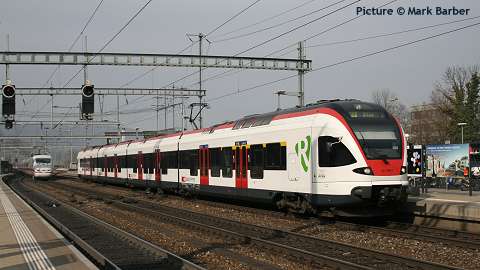
521 006 at Liestal, 20 February 2008.
The Beginning
After the great success of the Stadler 'Gelenktriebwagen' (GTW) in the national and international market, it became apparent that a great demand for a longer train containing similar elements was present. Both comfort and number of seats could be increased significantly. Added to this was that the GTW's Maximum speed of 140 km/ h was too low for many routes.The Objectives
The new unit train so should achieve the following objectives:- Improved comfort for the travellers, of the compartments, low noise level, state-of-the-art passenger information
- Variability of the interior
- Maximum speed 160 km/h
- Variable train length
- high proportion of low-floor space as possible, based on a platform height of 550 mm
- Powerful drive system for a high power-to-weight ratio with low energy consumption
- Multiple voltage and system capability
- Lightweight construction, with long service life and low maintenance requirements during the lifetime.
- An independent power car at each end
- Jacob trailer bogies giving low gangway height;
- Large body extrusions using aluminum technology
- Train options of from three to six sections
- Design for 160 km/h with development potential for 200 km/h.
The Concept
The implementation of the studies led to this train. The requirements have been adjusted to reflect the current needs, and designed so that the FLIRT (Flinker Leichter Innovativer Regional-Triebzug = Fast Light Innovative Regional Multiple Unit) is now available in the following variants:- Train length: two to six sections
- Number of gates: one or two per body and side
- Custom interior layout, from just a few seats up to a comfortable interior design; first class section, dining or buffet car
- Use on standard gauge or broad gauge lines;
- Body width according to the structure gauge as appropriate
- Overhead Voltage 15 kV AC, 25 kV AC or 3 kV DC - optionally Multiple 15/25 kV or 15/25/3 kV;
- Maximum speed 120-160 km h, designed to 189/200 km/h.
The first commission for a Stadler FLIRT came in 2002 from the SBB, for an S-Bahn train. The design and construction were a great challenge. Thanks to the efforts of all concerned, the first vehicle left the Bussnang factory in June 2004, and operation on the Swiss S-Bahn network began in December 2004.
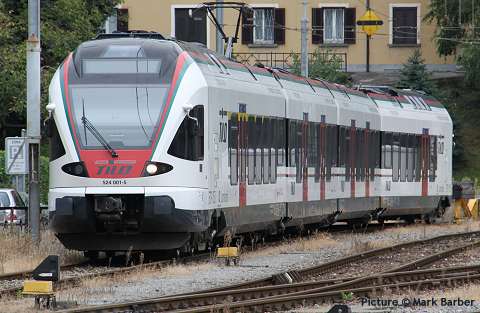
Ticino and Lombady (TILO) dual-voltage unit unit 524 001 at Bellinzona.
The Execution: Coach Body
The vehicle bodies are produced in Aluminium large-profile construction. These are standard profiles, supplemented by special sections used, which are connected by welding to the box. This creates a more robust, stiffer and more durable box, which is characterized by corrosion resistance, and less damage in minor accidents.Today's vehicle fronts are of composite construction, as was successfully used for the SBB Re 460 locos. The new European rules on collision strength require a new design, which is already under construction at Stadler GTW for delivery to the Netherlands. The first FLIRT with the new front-end design for the SBB are for use on the routes of the SNCF in Alsace.
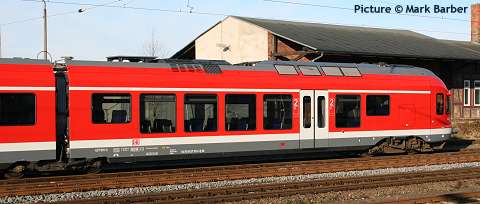
The DB FLIRTs have different running numbers for each coach in the set: above is 427 001, and below, 427 501, a DB Mecklenburg-Vorpommen 'Baltic Coast' set seen at Stralsund in March 2008. The centre cars were class 827. (These units were renumbered to Class 429 in 2009.)
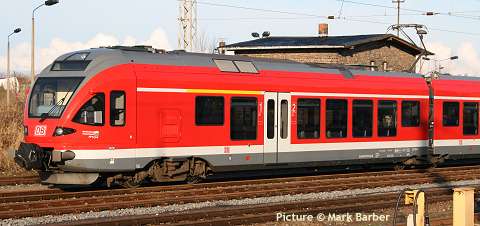
The interior's design is largely adapted to let the customer needs, which may perhaps even change during operation. For example:
FLIRT for the STA railway in the
'Adige': In summer, the crowds of cyclists are very large, so existing
winter compartments can be converted in the summer to cycle space.
NSB (Norway): A part of the fleet is designed for use on S-Bahn services. The rest, which are used on intercity traffic on the Oslo - Bergen and Oslo - Trondheim lines, have fewer doors and a custom interior.
NSB (Norway): A part of the fleet is designed for use on S-Bahn services. The rest, which are used on intercity traffic on the Oslo - Bergen and Oslo - Trondheim lines, have fewer doors and a custom interior.
Vehicles are equipped to the wishes of the customer, so that for example, the seating, the number of doors, the toilet equipment, the multipurpose area, or the passenger information system, are adjusted in response to the operational requirement. Common to all FLIRTs is the generous entrance platform, the flat transition from car to car, and a high fire resistance. Key comfort points are air-conditioned compartment with large windows that make travelling in FLIRT pleasant.
The cab meets the requirements of a modern, comfortable workplace for the driver. The driving position is always placed centrally, and is adapted to the specific requirements of each railway.
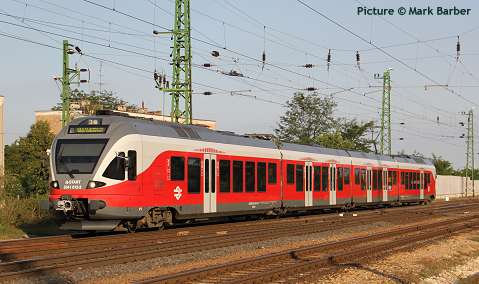
Above: Hungarian Railways MAV Start 5341 012 arriving at Hegyeshalom (Hungary/Austria) border station on 15 August 2009 with a service to Vienna. At the time these units had been banned from working into Austria so passengers had to change at this station.
Traction Equipment
A major design aim was that of optional multi-system electrical equipment for one possible widespread use in Europe. This goal has been completely achieved without limitation. Today, according to the common standard, each power car is driven through IGBT power converters. The whole drive is made by ABB Switzerland.Of course, the FLIRTs are equipped with regenerative brakes, supplemented as needed with brake resistors. The efficient dynamic brakes can be used as the service brake, so that the pneumatic brakes need only in emergencies.
The equipment used in the FLIRT is very efficient with an output of 1,300 kW per drive unit and gives the FLIRT a high acceleration and and ability to avoid delays. Moreover, it is very network-friendly, which offers an advantage especially for lines with lightly laid track.
Each power car has:
- Oil-cooled transformer on the roof
- Input power converter, with four-quadrant controler
- One motor current controller per traction motor
- Auxiliary converters to feed the internal circuits with 3 x 400 V / 50 Hz
- Auxiliary converters to feed the cooling circuits with variable frequency providing cooling for the inverter and traction motors
- Batteries
- Power converter control system.
The traction motors are of the externally-ventilated asynchronous induction 'squirrel-cage' type. They are bought in a stock items with the gearing, assembled into one unit. They are manufactured by TSA (formerly BBC / ABB - Elin) in Wiener Neudorf, Austria.
Bogies
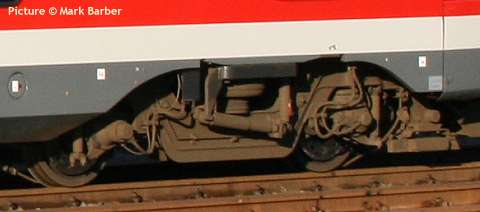
The power bogies (picture above) at each end of the train, are two-axle, air suspension bogies with welded H-frame. The traction motors with gearboxes are folly sprung on the bogie, so minimising track damage because the masses are decoupled. The torque is transmitted by cardan shafts to the wheels. The mechanical brakes operate on the wheel discs of all wheels. A number of the brake units are fitted with springs to act as parking brakes.
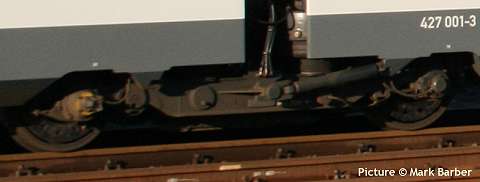
The unpowered bogies, each of which carries the ends of two adjacent coaches, supported on air springs, are the type known as 'Jacobs bogie', which give lowest access to the passenger area, and a wide, flat, passage between cars. They are also fitted with wheel disc brakes. (Picture above)
The bogies are for designed a maximum speed of 160 km/h. For the future - for example, in Norway - 200 km/h will be required, and development is in progress. On a test drive at that speed has already been successfully achieved.
Both the bogies as well as the trailer bogies were developed by Stadler and are manufactured by Stadler in the former SLM workshops in Winterthur.
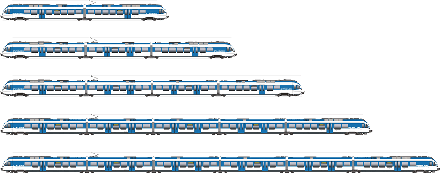
Fleets
By late 2008, FLIRTs have been built for the following networks:- 15 kV AC: Switzerland (SBB, SOB, TRN), Germany (including DB, Cantus, Abellio, Westphalia Rail, Euro Rail, Regen), Norway NSB
- 25 kV AC: MAV Hungary, Algeria SNTF, Finland VR
- 3 kV DC: Italy (Gargano, Ferrotramviaria), Poland (Mazovia and Silesia)
- 15 kV AC / 3 kV DC: Switzerland / Italy SBB, Italy / Austria (STA Pustertal)
- 15 / 25 kV SC: Switzerland-France
- 15 / 25 kV AC /3-1-5 kV DC: Tested on a vehicle, including under 1.5 kV on the Geneve-La Plaine line
The FLIRT is being built in the following works:
- Bussnang:
- Altenrhein
- Winterthur: all bogies
- Berlin-Pankow
- Siedlce (Poland): final assembly for PKP
- Hungary: extra capacity for bodyshells
- Two-car (one car powered) for Abellio (Germany),
- Three-car three parts for Cantus (Germany), Westfalenbahn (Germany)
- Four-car (by far the biggest number) among others SBB, SOB, TRN, Cantus, Republic of Finland, Algeria SNTF.
- Five-car for DB, Angel Trains, NSB (NSB units have a third power bogie)
- Six-car for SBB TILO (Ticino - Lombardy), STA (Pusteria)
- 126 four-cars for the SBB in various configurations
- 30 + 30 four-cars for Hungarian MAV
- 32 four-cars for the Finnish VR - the first broad-gauge version
- 64 four-cars for the electrification of the suburban rail network in Algiers
- 50 five-cars for the Norwegian NSB (with options for another 100) for S-Bahn traffic, and also intercity traffic on the Bergen line (Oslo - Bergen) and the Dovrebanen (Oslo - Lillehammer - Trondheim)
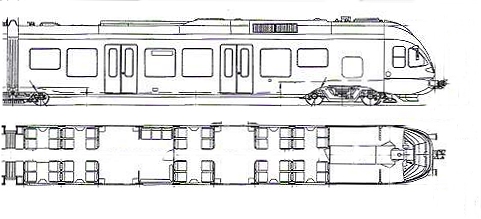
The future
Stadler is working on the development of all its products, including the FLIRT. Planned next steps:- The development of the already-mentioned new front end to
meet crash protection standards, for the SBB FLIRT France among others
(see below)
- The development of a diesel-FLIRT;
- Increasing the top speed to 200 km/h, for NSB Norway among others
- Performance.
From FLIRT (Alsace) to FLIRT (France)
Among the current developments of the FLIRT is a version for the international operation between Switzerland and France. The original idea of using a 15/25 kV dual-frequency option, combined with mechanical parts similar to the SBB FLIRT class 523, was brought into question by discussions with the French authorities.After extensive 'clarifications', SBB and Stadler were compelled to re-think. The new rules require, among other things, meeting crash standard EN15227, and other conditions in the field of brakes, couplings, pantograph and recorder. Because of these conditions, the SBB and Stadler have agreed to develop a 'FLIRT France' - unit numbers 522 201 - 214. This will satisfy the French standards, which differ greatly from the others in respect of details applying in Europe.
RABe 522 001 - 012, the already ordered dual-FLIRT, will be "helvetised" (converted to Swiss normal standards) and assume their duties as RABe 523 032-043, which had ordered in 2007 for the SBB S-Bahn services in canton Luzern and the Freiamt [south-eastern Aargau.] Two completed units, RABe 522 001-002, are being used temporarily for test running in France.
Through the use of 523 032 - 043 in central Switzerland, for this network originally ordered 523 013 - 024 FLIRTs be free for other tasks. They will in future be used along with seven other trains in the S-Bahn network RER Vaudois.
The bottom Line
The FLIRT is the most successful train in the corporate history of Stadler so far. From 2004 to 2008 514 vehicles had been sold. However, this success story would not have been possible without the GTW. The FLIRT builds on the concept and thus the success of the GTW.Page by Charlie Hulme January 2010